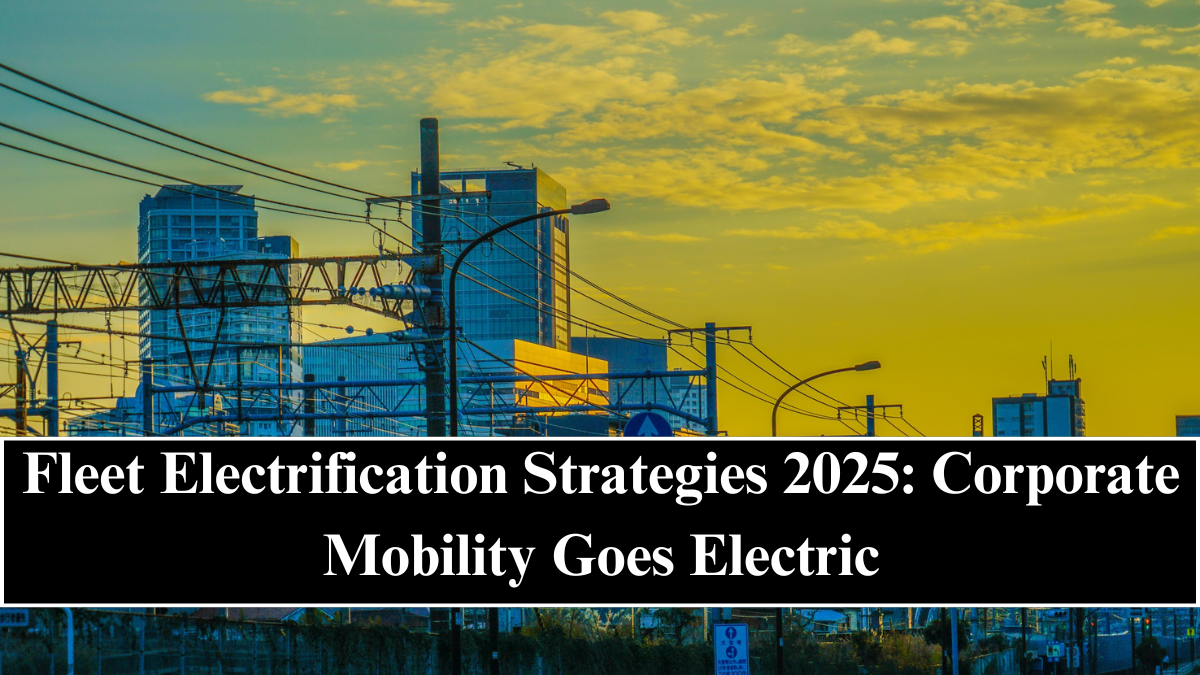In 2025, global corporations are accelerating the transition to electric vehicle (EV) fleets as part of their sustainability and cost-optimization strategies. What began as a green initiative is now a full-scale transformation — powered by data analytics, AI-driven route optimization, and stricter emission targets. Fleet electrification is no longer optional; it has become a key pillar of responsible business operations across logistics, delivery, and corporate transport.

Why Fleet Electrification Matters
Fleet vehicles account for a significant portion of road emissions globally. By switching to EVs, companies can drastically reduce carbon footprints, maintenance costs, and fuel dependency while aligning with ESG (Environmental, Social, and Governance) mandates.
In 2025, most large enterprises have adopted EVs not just for sustainability, but also for their economic and operational advantages:
-
Lower energy costs per kilometer
-
Simplified fleet maintenance
-
Reduced downtime due to fewer moving parts
-
Improved brand image and government compliance
With governments tightening emission standards and offering incentives, fleet electrification has evolved from a sustainability target into a competitive business advantage.
The Role of Data and AI in Electrified Fleets
Smart fleets in 2025 are powered by data-driven decision-making. Companies now use AI and telematics platforms to monitor performance, optimize charging schedules, and predict maintenance requirements.
Key data parameters include:
-
Energy consumption per route
-
Battery health and lifespan prediction
-
Optimal charging station locations
-
Driver behavior analytics
By using predictive algorithms, logistics firms can determine the most efficient routes, cutting both operational costs and emissions simultaneously.
For example, AI can analyze real-time weather and traffic data to decide whether to recharge en route or at the depot, maximizing fleet uptime and minimizing range anxiety.
Global Corporations Leading the EV Fleet Transition
-
Amazon continues to deploy electric delivery vans and trucks from Rivian and Mahindra across multiple regions.
-
UPS and FedEx are using advanced EV fleets with smart route optimization software.
-
IKEA and DHL have pledged to achieve 100% electric last-mile delivery by 2025.
-
Indian logistics leaders such as BluSmart and Etrio are expanding EV-based ride-hailing and logistics solutions.
This widespread adoption proves that electrified fleets are now mainstream mobility infrastructure, not experimental technology.
Charging Infrastructure and Fleet Management Integration
For electric fleets to succeed, charging infrastructure must scale alongside. Businesses in 2025 are investing in:
-
Depot-based fast charging hubs for overnight fleet charging
-
On-route charging stations to support long-haul logistics
-
Renewable energy integration, where solar panels and microgrids power fleet depots
Fleet management systems now feature charging analytics dashboards, allowing companies to track power usage, optimize costs, and balance grid load. Many corporations even partner with utility providers to ensure dedicated green power supply for their EV fleets.
Financial and Policy Incentives for Fleet Electrification
Governments worldwide are driving corporate adoption through financial incentives and tax benefits:
-
Subsidized EV procurement and tax deductions on fleet conversions
-
Zero-emission zones rewarding businesses with carbon credits
-
Reduced registration fees and toll exemptions for commercial EVs
In India, schemes like FAME-II and PLI (Production-Linked Incentive) have accelerated fleet electrification across logistics and mobility startups. Similarly, in Europe and North America, tax credits under green mobility acts have made EV adoption economically viable for corporate fleets.
Challenges in Fleet Electrification
Despite rapid progress, fleet electrification still faces several operational challenges:
-
High upfront investment in EVs and charging setup
-
Battery degradation due to high daily usage
-
Grid dependency in regions with unstable power supply
-
Lack of standardization across charging connectors and management platforms
To overcome these issues, businesses are adopting battery leasing, energy storage solutions, and AI-powered battery management systems (BMS) to ensure cost and performance balance.
The Future: Data-Driven, Fully Electric Fleets
By the end of 2025, corporate fleet electrification is expected to account for 20–25% of all new vehicle sales globally. The next step involves complete automation — self-managing electric fleets that use AI to predict energy requirements, schedule recharging, and perform autonomous diagnostics.
With increasing integration of V2G (Vehicle-to-Grid) systems, fleets will soon act as mobile energy storage units, supporting smart grid efficiency. The transformation is not just about replacing vehicles but about building intelligent, circular mobility ecosystems.
FAQs
What is fleet electrification?
It’s the process of replacing traditional fuel-based fleet vehicles with electric vehicles to reduce emissions and operating costs.
Why are companies electrifying their fleets in 2025?
Businesses are adopting EV fleets to meet ESG goals, reduce fuel expenses, and comply with stricter emission regulations.
How does AI help in managing EV fleets?
AI analyzes routes, traffic, energy use, and battery data to optimize performance and lower downtime.
What are the main benefits of electric fleets?
Lower operating costs, improved sustainability, and enhanced corporate reputation make electrified fleets a strong investment.
Are charging infrastructures sufficient for fleets?
Yes, with expanding fast-charging networks and dedicated depot solutions, most fleets now operate with efficient charging support.
Click here to know more.
